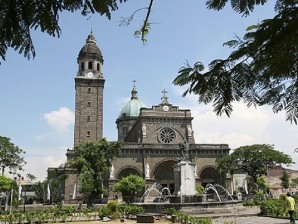Liquor ban imposed in Manila for Pope’s visit

The Manila cathedral. Mayor Joseph Estrada has set a one-kilometer radius liquor-free zone from Manila Cathedral on Jan. 16, where Pope Francis will hold a Mass. INQUIRER FILE PHOTO
MANILA, Philippines–During the visit of Pope Francis on Jan. 15 to Jan. 19, parts of Manila will be liquor-free.
Mayor Joseph Estrada has signed Executive No. Order 2, which restricts the purchase of intoxicating beverages in parts of the city during the papal visit.
Estrada explained that the liquor ban would be imposed to maintain peace and order during the visit of Pope Francis.
“The Manila Police District and the Manila Disaster Risk Reduction and Management Office have recommended the issuance of an executive order regulating the sale or consumption of alcoholic and intoxicating liquors in the City of Manila to ensure public order and safety during the said occasions,” the order read.
Throughout the papal visit, “no person shall sell, offer, serve, buy or take beer, wine or intoxicating liquors on any street, sidewalk, plaza or any other place within 200 meters” of the Apostolic Nunciature and wherever the papal motorcade will pass through, it said.
The Apostolic Nunciature, along Taft Avenue near Quirino Avenue, in Malate, Manila, will be the residence of Pope Francis during his visit.
The stretch of Taft Avenue and Leon Guinto Street from Quirino Avenue to Ocampo Street will also be closed to traffic during the entire length of the Pope’s visit.
Aside from these prohibitions, Estrada also set a one-kilometer radius liquor-free zone from Manila Cathedral on Jan. 16, where Pope Francis will hold a Mass together with clergy from different parts of the country.
This one-kilometer liquor-free zone will also apply at the University of Santo Tomas on Jan. 18, where the Pope is expected to meet with religious leaders and the youth; and at Quirino Grandstand and Rizal Park, also on the same day, when he will preside over a Mass as his final public appearance in the country.–Nathaniel R. Melican
RELATED STORIES
DFA suspends consular services in Metro Manila for papal visit
Pope Francis PH ‘state visit’ unlike trips of other heads of state